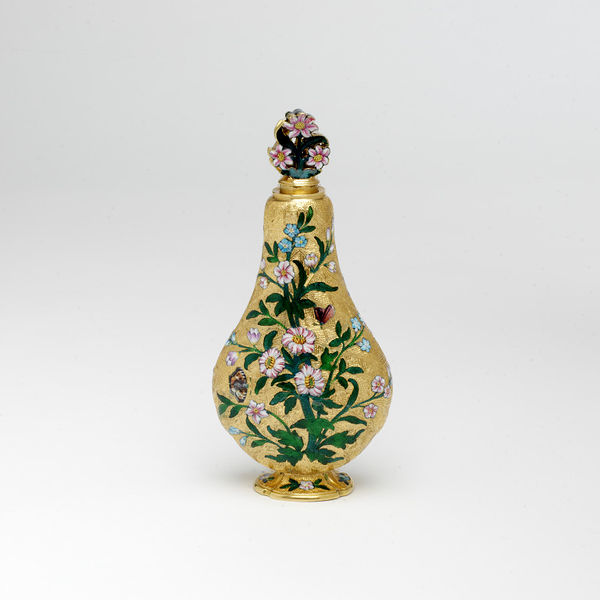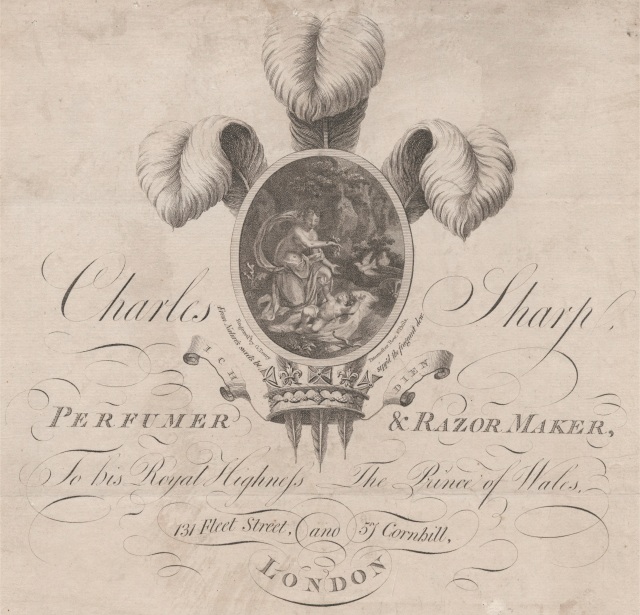Today I thought we would take a look at some Georgian recipes for making perfume, most of them are still feasible to make at home today with some minor adjustments.
To perfume clothes
Take of oven-dried cloves, cedar and rhubarb wood, once ounce of each and beat them into a powder and sprinkle them in a box or chest where they will create a most beautiful scent and preserve the apparel against moths.

Perfumed bags for drawers
Cut, slice and mix well together into a rough powder the following ingredients
2oz. of yellow saunders, the same of coriander seeds, orris root, calamus aromatics (sweet flax), cloves, cinnamon bark, dried rose leaves, lavender, and 1lb. of oak shavings.
When properly mixed, stuff the above into small linen bags, which place in drawers, wardrobes, which are musty, or liable to become so.
Perfume for gloves
Take one drachm of ambergris and sieve; add quarter of an ounce of flour-butter and mix together well. Rub the gloves over gently with fine cotton wool and press the perfume into them.
Or
Take half an ounce of damask or rose scent, a drachm of the spirit of cloves and mace, and a quarter of an ounce of frankincense,. Mix them together, and lay them in papers, and when hard, press the gloves; they will absorb the scent in 24 hours, and hardly ever lose it.
Pastils for perfuming sick rooms
Reduce the following to a powder separately on a marble slab and then mix –
1 lb. of gum benzoin, 8 oz. of gum storax (used to treat wounds, infections and coughs), 1 lb. of frankincense, and 2 lbs. of fine charcoal.
Add to this composition the following liquids:
6 oz. of tincture of benzoin, 2 oz. of essence of ambergris, 1 oz. of essence of musk, 2 oz. of almond oil, and 4 oz. of clear syrup.
Mix the whole into a stiff paste, and form into pastils, of a conical shape, which dry in the heat of the sun.
If more liquid should be required for the paste, add warm water.

Ambergris Perfume
Melt penny-weights of fine ambergris, in a brass mortar very gently then stir in quickly, 8 drops of green lemon juice, and the same of behn-nut oil (or almond oil). Add, ready powdered with fine loaf-sugar, 12 grains of musk, 12 grains of civet, and 24 grains of residuum from the making of spirit of ambergris.
Add one ounce of spirit of ambergris, mix and incorporate them well, and add 16 pounds of fine dry hair-powder.
Pass twice, through a fine hair sieve; then lay it open for three days, in a dry room, stir it often, until the spirit evaporates, Bottle and stop it close.

Orris Perfume
Take best dried and scraped orris roots which should be free from mould. Bruise or grind them, the latter is best, as, being very tough, they require great labour to pound. Sift the powder through a fine hair sieve, and put the remainder in the oven, to dry the mixture. A high temperature will turn the roots yellow. Once dry, grind again, and sift; and repeat the same until the whole has passed through the sieve. Mix nothing with it, as it would mould and spoil.
Violet Perfume
Drop twelve drops of genuine oil of rhodium on a lump of loaf-sugar; grind this well in a glass mortar and mix it thoroughly with three pounds of orris powder.
This will, in its perfume, have a resemblance to a well-flavoured violet. If you add more rhodium oil, a rose perfume, instead of a violet one will be produced; the orris powder is a most agreeable perfume, and only requiring to be raised by the addition of the above quantity of the oil. According to the author, it is better to make your own as what is sold at the druggist’s shops is generally adulterated.
Rose Perfume
Take two pecks of fresh, dry damask rose-leaves; strip them from their leaves and stalks; have ready 16 pounds of fine hair-powder. Strew a layer of rose-leaves, on sheets of paper, at the bottom of a box, cover them over with a layer of hair-powder; then strew alternately a layer of roses and powder, until the whole of each has been used.
Leave for twenty four hours, then sieve the powder out, and expose it to the air for a further twenty four hours, stirring regularly. Add fresh rose-leaves, twice, as before, and proceed in the same way; after this dry the powder well by a gentle heat and pass it through a fine sieve.
Lastly, pour ten drops of oil of rhodium, or three drops of otto of roses, on loaf-sugar, which triturate in a glass mortar, and stir well into the powder, which put into a box, or glass, for use. This hair-powder perfume will be excellent and will keep well.
Bergamot Perfume
Take sixteen pounds of hair powder, and forty drops of Roman oil of bergamot, and proceed in all respects as before, but do not leave the compound exposed to the air as the bergamot is so volatile that it will evaporate.

If none of these appealed then of course you could buy perfume from a perfumery or chemist, such as Simmons and Kirkby in Canterbury, who would sell you musk, orange, bergamot and so on for just one shilling a bottle – perhaps an easier option.
Source
The British perfumer: being a collection of choice receipts and observations by Charles Lillie
Kentish Gazette 10 July 1779
Featured Image
Metmuseum



Excellent sleuthing!
Partly these perfumes were to make you smell pleasant, but also to mask the smell of the streets and the unwashed. Masking those smells would be seen as a way to keep healthy.
LikeLiked by 1 person
Where can we obtain orris root and ambergris.? The quantities seem enormous.
>
LikeLike
Orris root is readily available to purchase online, but ambergris is expensive and as I understand it, not readily available, although tincture of ambergris can be purchased. Try doing an online search and you’ll see what I mean about the price of ambergris 🙂
LikeLike
Such a great article, and I love that you illustrated it with a Wedgwood scent bottle! These are all solid perfumes though – have you come across recipes for liquid, alcohol-based perfumes as well, or were those not something people would have made at home?
Hillwood mansion in Washington, DC had an exhibit of perfume bottles last year, and the curator explained that bottles evolved when liquid perfume became available. For solids or powders, like smelling salts, you would have used a vinaigrette.
LikeLike
Thanks Sophie, thought you’d like the Wedgwood bottle! 🙂 I didn’t come across any that weren’t solid, but I will do some more research, although I’m not sure such perfumes would have been made at home.
LikeLike
Pingback: Georgian Perfume | First Night History
The perfume bottles are beautiful
LikeLiked by 1 person
Great piece – can’t wait for my butler to come back from self-quarantine to pick up traditions from the Georgians!)
LikeLiked by 1 person
Hi, thank you for such a brilliant post. I have been reading some blogs that gives me more knowledge about Georgian perfume. I must say this is one of the best among them. You have done a great research for I feel, thanks for sharing.
LikeLike
Thank you so much Marc, delighted you enjoyed it 🙂
LikeLike